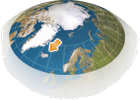 |
The Hunter And
The Primitivist Fallacy |
| |
A longstanding tradition in Western
discourse classifies hunters and gatherers as 'food collectors'
operating outside society. Thus, Marx and Engels argued that humans
'begin to distinguish themselves from animals as soon as they begin
to produce their means of subsistence' (cited in Ingold 1988: 270).
From this perspective, hunters and gatherers are not 'producers'
of food, as they simply consume what nature provides, unlike agriculturalists
who really transform their means of subsistence. By extension, hunter-gatherers
are permanently in the state of nature. |
| |
Few people nowadays may subscribe
to such a view. And yet many people are committed to a view of 'simple'
societies that logically seems to lead to a similar conclusion.
Some anthropologists and many environmentalists assume that the
members of simple societies are above all 'rational' beings who
always find the right solutions to their problems. This notion is
reflected in the primitivist fallacy of ecological functionalism
which assumes that simple societies are closed systems in perfect
harmony with their environment (see Ellen 1982: 73). 'They' adapt
and ensure the sustenance of renewable resources while 'we' ruin
the environment and drive the ecosystem out of balance and control.
Given such assumptions, in 'simple' societies people always develop
sound analyses of ecology and environmental problems, unable to
make mistakes. As McGoodwin remarks, this is 'practically a cliché
in the litearature concerned with preindustrial peoples' (1990:56).
The behaviour of hunters and gartherers, especially, is assumed
to be responsive to ecological relations. |
| |
To some extent, perhaps, this view
was necessary to redress the balance, to contest the earlier, ethnocentric
view of Tylorian intellectualists, for whom 'primitives' were disadvantaged,
badly informed, and generally seriously misguided in their efforts
to understand the world (Kuper 1988). The image of hunters and gatherers
as lay ecologists, then, has replaced their image as primitives
(see Bettinger 1991). However, the model of the lay ecologist is
equally simplistic. It, too, assumes that material context largely
accounts for what hunter-gatherers do. They are no longer, perhaps,
regarded as fossils from the remote past, but they clearly adapt
to the ecological conditions that prevail. They are no longer at
the 'edge' of subsistence, but unlike us they are permanently in
the state of nature. |
| |
Such an idea is illustrated by Mauss's
work (1979[1906]) on the coastal economy of the Inuit, an early
work that to some extent anticipates the modern model of the lay
ecologist. Mauss's analysis hinges on the simple ecological observation
that the Inuit as well as the animals they hunt disperse and concentrate
according to season: |
| |
In summary, summer opens up an almost
unlimited area for hunting and fishing, while winter narrowly restricts
this area. This alternation provides the rhythm of concentration
and dispersion for the morphological organization of Eskimo society.
The population congregates or scatters like the game. The movement
that animates Eskimo society is synchronised with that of the surrounding
life (Mauss 1979:56). |
| |
During the summer, the Inuit are isolated
and fragmented. According to Mauss, 'there is no religion' since
the myths that 'fill the consciousness of the Eskimo during the
winter appear to be forgotten during the summer' (p. 75). 'Life',
he adds, 'is that of the layman'. During the winter, on the other
hand, when the population congregates, there is a 'genuine community
of ideas'. The contrast between summer and winter, then, parallels
that between individual and society. In the individual mode, during
the summer, the Inuit are 'lost children, as it were' (Mauss 1979:52),
providing for themselves as individuals. The isolated hunters or
fishermen keep their kill to themselves without having to consider
anyone else. During the winter, on the other hand, individuals become
social beings. The producers become subject to strict rules concerning
the distribution of food. Food is collectively shared within a settlement
rather than being limited to the individual or nuclear family. This
suggests that the Inuit are perennially split between the individual
and collective, the natural and social. In winter there is a lot
of society in the individual; in summer, much less. Given such distinctions,
hunting must take place in nature. The appropriation of nature only
becomes social when the resources extracted from nature enter relations
of sharing or exchange among groups (Pálsson 1991: Ch. 1). |
| |
The idea of subsistence hunters as
lay ecologists or 'noble savages' operating ouside, or on the margin
of, society in an isolated world of their own has often appeared
in recent debates on animal rights. While animal rights activists
like to think of themselves as the spokespersons for indigenous
hunters, they often misconstrue the hunters' thinking and way of
life, as anthropologists have recently pointed out. Animal rights
activists share the hunters' respect for animals and their concern
with environmental problems, but in many other respects the two
groups are likely to disagree. Trapped in objectivist, Western discourse
on science and the Other, animal rights activists make a fundamental
distinction between 'them' (indigenous hunters) and 'us' (Euro-Americans),
between nature and society, and between animals and humans. This
contrasts sharply with the ways in which hunters themselves often
represent their relations with society and the animate world. Thus,
Inuit and Cree think of themselves as being in communion with nature,
animals, and fellow humans (see Wenzel 1991). In their view, there
is no fundamental distinction between nature and society, animals
are regarded as social persons, and to kill them is a sign of responsibility
and not a criminal act, at least as long as certain technical and
ritual conditions are met. |
| |
The environmentalist view may express
charitable and humanitarian motives. However, it is not an objective
account of the real world but an ethnocentric statement grounded
in the historical realities of particular groups of Euro-Americans.
Humans, whatever their mode of production or subsistence, are simultaneously
part of nature and society. |
|
